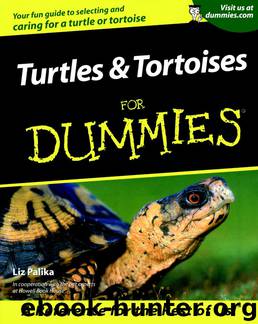Turtles & Tortoises For Dummies by Liz Palika

Author:Liz Palika
Language: eng
Format: epub
Publisher: Wiley
If you need assistance in wading through technical jargon in this chapter, check the list that follows for quick definitions:
Basking site or basking light: An area for a tortoise to absorb warmth from sunshine or another heat source
Carapace: The top shell covering the back
Clutch: A nest of eggs
Hatchlings: Baby tortoises
Herbivore: A plant eater
Flip to Chapter 15 for tips on building an outdoor enclosure.
Sulcata Tortoise (Geochelone sulcata)
The sulcata is the third largest tortoise species, with adult males often reaching 200 pounds. Lengths routinely reach 30 inches. The carapace is tan in color and has a low, curved shape (not domed like that of the leopard tortoise — see Chapter 12). The back legs have tubercles or spurs. The skin is also tan in color.
The sulcata (Geochelone sulcata) has been called the African spur-thigh tortoise. To confuse things, the North Africa tortoise (Testudo graeca) has also been called a spur-thigh. Experts are now trying to clarify things, and the sulcata is being referred to as a sulcata, while the Testudo graeca is being called the North African tortoise (see Chapter 10 for details).
Geographical origin: Africa, from Ethiopia and Sudan westward through Chad, Niger, and Mali to Senegal. This tortoise generally ranges along the southern edge of the Sahara Desert.
Native habitat: Varied, from desert fringes to grasslands and dry savannas.
Captive environment: This hardy, resilient, and adaptable tortoise requires a lot of room. Keep an adult in a yard no smaller than 10 yards x 10 yards. A doghouse with an incandescent red bulb for heat provides shelter and a hiding place.
These tortoises will dig if you don’t provide adequate hiding places. They can dig tremendous burrows, excavating tremendous volumes of dirt! Many times, you can prevent this behavior by offering a number of different places to hide.
If you adopt a sulcata, the walls or fence around your yard must be solid, secure, and into the ground. These tortoises are amazingly strong, are very curious, and don’t take no for an answer! If a sulcata can see through a fence, it may muscle its way through, taking the fence down in the process. Concrete walls are the best restraint, but the walls must be higher than the tortoise is long. A large female of mine was able to climb up a 16-inch-tall restraining wall, where she got into the flower bed and proceeded to mow down six rose bushes!
Diet: This tortoise likes to graze and can keep a grass lawn mowed quite nicely. In addition, feed a standard, varied herbivore diet. A bale of alfalfa hay in the tortoise yard is a good source of food and fiber. Because these tortoises grow so rapidly, give a daily vitamin/mineral supplement with a calcium:phosphorus ratio of 2:1. A cuttlebone, which is a hard chunk of calcium from a cuttlefish (as pet birds eat), also provides calcium.
Breeding: Sulcatas are breeding very well in captivity, so much so that you won’t have a tough time buying a captive-bred juvenile. One sulcata owner said that breeding sulcatas is something
Download
This site does not store any files on its server. We only index and link to content provided by other sites. Please contact the content providers to delete copyright contents if any and email us, we'll remove relevant links or contents immediately.
Sapiens: A Brief History of Humankind by Yuval Noah Harari(14252)
The Tidewater Tales by John Barth(12608)
Mastermind: How to Think Like Sherlock Holmes by Maria Konnikova(7227)
Do No Harm Stories of Life, Death and Brain Surgery by Henry Marsh(6891)
The Thirst by Nesbo Jo(6826)
Why We Sleep: Unlocking the Power of Sleep and Dreams by Matthew Walker(6618)
Life 3.0: Being Human in the Age of Artificial Intelligence by Tegmark Max(5474)
Sapiens by Yuval Noah Harari(5294)
The Longevity Diet by Valter Longo(5019)
The Body: A Guide for Occupants by Bill Bryson(4974)
The Rules Do Not Apply by Ariel Levy(4861)
The Immortal Life of Henrietta Lacks by Rebecca Skloot(4525)
Animal Frequency by Melissa Alvarez(4395)
Why We Sleep by Matthew Walker(4360)
The Hacking of the American Mind by Robert H. Lustig(4318)
Yoga Anatomy by Kaminoff Leslie(4306)
All Creatures Great and Small by James Herriot(4232)
Double Down (Diary of a Wimpy Kid Book 11) by Jeff Kinney(4207)
Barron's AP Biology by Goldberg M.S. Deborah T(4097)
